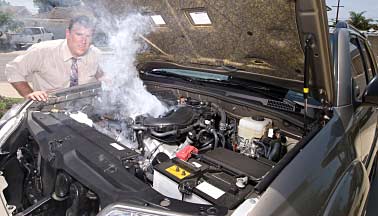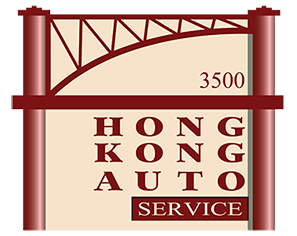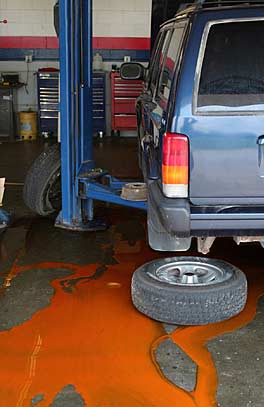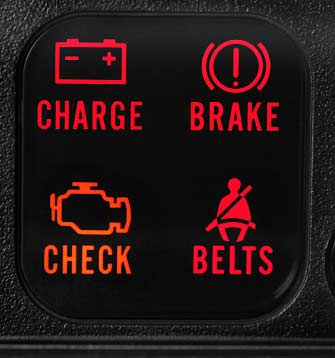Help! Know when to pull over ASAP and when it's OK to continue on your way
When most of us learned to drive, there were three dashboard indicators we needed to be aware of: the battery light, the engine temperature gauge and the oil light. And if the oil light came on, we knew it was serious and that we needed to pull over immediately.
 Today’s sophisticated cars light up like a holiday tree, and even experienced drivers can have trouble deciphering all of the warnings and notifications. (For some examples, see Car Warning Lights.) Now imagine you’re a college freshman on the way back to campus for the fall, and your dashboard lights up with an orange exclamation point flanked by two parentheses that look like a failed emoticon experiment. While the owner’s manual is handy at explaining what the light is for, it isn’t likely to help you decide whether you need to pull over immediately or whether you can continue on and seek help once you get to school.
Today’s sophisticated cars light up like a holiday tree, and even experienced drivers can have trouble deciphering all of the warnings and notifications. (For some examples, see Car Warning Lights.) Now imagine you’re a college freshman on the way back to campus for the fall, and your dashboard lights up with an orange exclamation point flanked by two parentheses that look like a failed emoticon experiment. While the owner’s manual is handy at explaining what the light is for, it isn’t likely to help you decide whether you need to pull over immediately or whether you can continue on and seek help once you get to school.
Last month, we wrote an article about preparing your teen driver for driving alone and responding to roadside breakdowns. This month, we’re going to help you and your teens decide when to pull over immediately and when you can safely continue your drive.
Pull Over Immediately
There are only a handful of situations that require you to pull over immediately—and by “immediately,” we mean asap but make sure you’re safely off the road. If you’re really lucky, you were right at an exit and have found a parking lot.
Pull over immediately if:
- You see steam or smoke coming from under the hood. Pull over and shut off the engine. Call for assistance. Move away from the vehicle in case the smoke is from an underhood fire.
- Your engine temperature gauge goes into the “red zone.” Pull over and shut off the engine. Call for assistance. If you are outside cell phone range, give the engine ample time to cool down. Start again, monitor the temperature gauge and try to get somewhere within cell phone range.
- You have a flat tire. (If you can drive slowly to the next exit with your flashers on, you may ruin your tire and wheel, but you will be safe. Changing a tire along a highway is extremely dangerous and the cost of a new wheel and tire is not worth risking your life.)
- Your oil pressure light comes on. Pull over and shut off the engine. If you continue to drive, you risk seizing the entire engine. Check the oil level. If it’s low and you have a known oil leak, you may just need to add a quart of fluid. If it’s low and you are not aware of an oil leak, you are better off calling for assistance. You could add more oil and try driving a few more miles, but if you don’t know where the leak is, you could be gambling with the engine.
- Your brakes do not seem to be responding. You may be pressing the pedal, and nothing is happening. Or you press the pedal, and it goes immediately to the floor. There is likely a brake fluid leak, and this is a very dangerous situation. Coast to safety and call for a tow truck. Do not attempt to drive this vehicle.
- The tires don’t move with the steering wheel. This is an extreme scenario, but it happens here in the spring with all the warm weather and blossoming potholes. If you cannot turn the steering wheel or it turns and the wheels don’t seem to move, something important is broken. You don’t have a choice here. You are not going anywhere without a tow truck.
If you have to stop along the highway, always pull off to the right shoulder as far as possible while remaining on solid, level ground and turn on the flashers. If the car is in the roadway, stand away from the vehicle until help arrives. If your car is safely out of traffic, wait inside the vehicle with the doors locked. Never stand in front of or behind the vehicle. It is too easy to be struck by oncoming cars. (For more safety tips, read What to do When Your Car Breaks Down from AAA.)
Help Will Soon Be Needed
If your scenario is under this heading, get to your destination or an alternate one as soon as possible. Your vehicle is operating on borrowed time.
- Your dashboard lights up with the battery/alternator light. This generally indicates a problem with your starting or charging system, which means if you pull over and stop the engine, it may not restart. It’s better to drive the vehicle home, to your auto repair shop or to an alternate destination from where it can be towed if needed. Turn off and unplug all unnecessary accessories, such as the stereo, to preserve battery power.
- You’re unable to steer. If your power steering fails, it could be a very tiring, difficult and even dangerous ride home, especially if your car uses drive-by-wire technology.You wouldn’t be able to react to other drivers’ moves or to suddenly swerve to avoid something in the roadway. The smartest move is probably to call a tow truck.
- Your low coolant light comes on. This means the car is low on coolant, which can cause the engine to overheat. Keep an eye on the temperature gauge as you proceed to the nearest travel station that sells antifreeze. Check the coolant level by looking at the overflow tank or following the instructions in your owner’s manual. DO NOT open the radiator cap. You risk severely burning yourself. If your coolant is low, add some more through the overflow tank. (Try to buy pre-mixed coolant that is 50 percent antifreeze, 50 percent water. If you cannot, use straight antifreeze but mention it to your auto technician when you take the vehicle in for service.) If the coolant appears to be ok, you may have an air pocket in the cooling system. Continue on your trip but keep an eye on the temperature gauge. Exit the highway or pull over if it goes near the red zone.
- You have a major fluid leak. If you stop for gas and suddenly see a puddle underneath your car, you may have a major leak. Take the time to check all the fluid levels. If something has just broken or failed, you will likely find the culprit. Decide if you need to call a tow truck by weighing what the fluid’s function is, how much farther you have to go, how much fluid has leaked, and how much fluid (if any) continues to leak once you add more. At the very least, replenish the fluid, go a couple of miles down the road and check the fluid level again.
Continue Your Trip, But Schedule An Appointment for Service
- Your Service Engine Soon light is on steady or is blinking. Although this needs attention, a sole Service Engine Soon light is not a reason to pull off the roadway. It’s related to a fuel or engine emissions issue and will not leave you stranded. However, if the light is blinking, this is more serious. A flashing light means the engine is misfiring. Your engine computer may be covering enough that you don’t notice, but the computer knows. Finish your trip, but call for service in the morning. Prolonged misfiring in the engine can cause more serious problems.
- Your red brake light is on or comes on intermittently. This often indicates that the parking brake is not full disengaged or that the brake fluid level is low, particularly if the light is coming on around sharp turns or during hard stops. This could just be an indicator that you need new brakes. If your pedal is firm and the brakes responsive, you are most likely okay to continue your trip. If the pedal is soft and the brakes unresponsive, see the brakes listing under “Pull Over Immediately.”
- Your antilock brake (ABS) light is on steady. This means the car has detected a problem with the antilock brakes and has disabled them. They will not activate if needed. Your regular brakes will continue to operate properly. Just remember to pump them if you begin to skid for any reasons. While this can be a safety issue in inclement weather, your OK to continue on and seek service help at your earliest convenience. (Note: Your ABS light will often flash if you press on the brakes, and the ABS kicks on.)
- Your airbag (SRS) light is on. This is very similar to the ABS light. The vehicle has detected a problem with the airbag system and has disabled them. They will not activate in the event of a collision. While this is a clear safety issue if you’re in an accident, you are OK to finish this trip and seek help at your earliest convenience.
- You have a minor fluid leak. If you have a low fluid warning light turn on or stop for gas and see a small dripping beneath your car, you likely have a fluid leak. Try to determine which fluid it is by looking at the color and giving it the “sniff” test. Take the time to check and top off all the fluid levels. If you are confident it’s a small leak, continue on your way but periodically stop to check the fluid level.
Related Reading:


